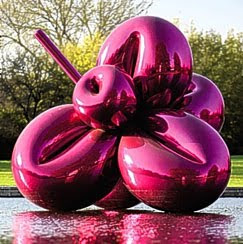
Originally Jeff Koons was supposed to make a calendar for a gallery but when he was blowing up balloons to photograph it gave him the idea to make balloon sculptures. The flower sculpture in particular is about spring time and new life. In order to create "Balloon Flower" Koons had to blow up many different balloons until he found the perfect one to imitate. The theme behind "Balloon Flower" is the delicacy of life and the importance of each moment. Real balloons lose air over time and gradually deflate which is a symbol of death. The sculpture, however, maintains form and the optimism of life. It endures and sustains life.
Andy Warhol is known for using everyday objects in his art. He used Campbell's soup cans and Brillo boxes. Balloons and flowers are also everyday objects. They are both playful and fun to look at. Andy Warhol used repitition to make his displays memorable and Jeff Koons used enlargement and vibrant color. Most of Koons' works are three dimensional whereas Warhol's are two dimensional. The depths are different because Koon's is illustrated by creases and curves. Warhol painted three dimensional objects in order to create depth. They are both talented artists that used everyday objects to inspire people.
In "Balloon Flower", the magenta version, the sculpture is able to reflect images off of its surface. It allows its audience to see themselves on the sculpture. Koons felt this was important because he wanted people to reflect their lives to the sculpture. When I look at "Balloon Flower" it reminds me of childhood. When I first looked at it I thought of a time when I was younger and my family took me to the fair. There was a guy who would make any balloon shape you wanted. It was a fun time and a happy memory. The balloon sculpture is simple yet fascinating. It is beautiful and brings me happiness.
Andy Warhol is known for using everyday objects in his art. He used Campbell's soup cans and Brillo boxes. Balloons and flowers are also everyday objects. They are both playful and fun to look at. Andy Warhol used repitition to make his displays memorable and Jeff Koons used enlargement and vibrant color. Most of Koons' works are three dimensional whereas Warhol's are two dimensional. The depths are different because Koon's is illustrated by creases and curves. Warhol painted three dimensional objects in order to create depth. They are both talented artists that used everyday objects to inspire people.
In "Balloon Flower", the magenta version, the sculpture is able to reflect images off of its surface. It allows its audience to see themselves on the sculpture. Koons felt this was important because he wanted people to reflect their lives to the sculpture. When I look at "Balloon Flower" it reminds me of childhood. When I first looked at it I thought of a time when I was younger and my family took me to the fair. There was a guy who would make any balloon shape you wanted. It was a fun time and a happy memory. The balloon sculpture is simple yet fascinating. It is beautiful and brings me happiness.
Bibliography
"Balloon Flower opens in SW1." Arts and Exhibition News. 2009. ES London Limited, Web. 23 Nov 2009.http://images.google.com/imgres?imgurl=http://i.thisislondon.co.uk/i/pix/2008/05/25a_23_koons_243x244.jpg&imgrefurl=http://www.thisislondon.co.uk/arts/article-23486902-balloon-flower-opens-in-sw1.do&usg=__94vU4tKkQ9k8qGp2yBxYTYuxwd8=&h=244&w=243&sz=28&hl=en&start=2&sig2=lzpRuNWKW3QQOikk4XiQ0w&tbnid=DLDxRmI5Ojuk9M:&tbnh=110&tbnw=110&prev=/images%3Fq%3Djeff%2Bkoons%2Bballoon%2Bflower%26gbv%3D2%26hl%3Den&ei=XQ4LS42OEoq1tgeP7KiLCA.
"Jeff Koons Speaks: Balloon Flower (Magenta)." Christie's. 2009. Christie's, Web. 23 Nov 2009.http://www.christies.com/features/videos/interviews/jeff-koons-balloons.aspx.

